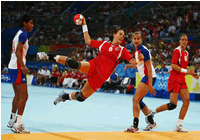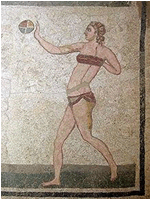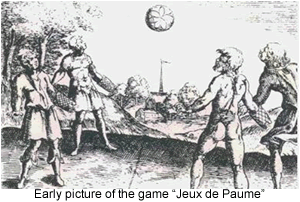
Team handball is an exciting sport to watch and exhilarating to play. Sometimes described as soccer with your hands, it offers fast and continuous play involving running, throwing, catching and jumping.
Team handball (also sometimes called field handball, Borden Ball, European handball, or Olympic handball) is a team sport, where the teams attempt to pass a ball to each other and to throw it into the opposition’s goal.
The two teams consist of seven players (including one goalkeeper) on each team. The goal that is used is similar to a soccer goal, and the court slightly larger than a basketball court.
As the name suggests, the ball is always transferred with the player’s hands rather than with their feet, so kicking the ball is an illegal move.
The ball is a little smaller than a soccer ball which allows players to hold and pass while only using one hand (though using both hands is allowed).
Early Origins of Team Handball
Although it has only been played internationally since the 1920s, the origins of team handball go back a long way. In fact, it is thought to have developed from some of the oldest games the human race has ever enjoyed. Most sports have their origins in popular games that were played for fun throughout history, and there can be nothing that has been more universally played than various types of ball games. Even now in our digital age, kids and adults alike cannot replace the enjoyment they get from games and sports involving simply kicking or throwing a ball.
Variations on the game of handball have been played all over the world for thousands of years. Historians argue that handball or games from which it developed are more likely to have been played than soccer would have been among early peoples, as human beings have always been better at manipulating objects with their hands rather than with their feet.
Roman and Egyptian ties to Handball?

The origins of the game are in fact likely to date from ancient Greek and Roman times. The ancient Greeks played a similar game called urania, from which handball may have been eventually derived. Noted in Homer’s Odyssey, urania involved the use of a ball made of purple wool.
In Rome, they played Harpaston, a game involving throwing a ball over a line. Historical evidence indicates that games not unlike handball were also played by the Inuit on Greenland and as far afield as Ancient Africa, mostly in Egypt.
There are drawings of Egyptians playing handball decorating the five thousand year old tombs at Saqqara in Egypt, which depict girls in pairs playing the game. Egyptian handballs were made of a leather skin stuffed with plant fibers so that they remained both light and durable.
European Handball Origins:
Ball games were equally popular in Europe. The history of European handball is well documented. In medieval Germany, a sport, known as fussballspiel, translates as “catch ball game.” During the Middle Ages in France, a game known as “jeux de paume” (palm play) was popular with rich and poor alike. The ball was made out of pieces of tightly-rolled material which were sewn together, and as the game changed over time, gloves were worn to allow the participants cheap provigil. This was probably a precursor of tennis – the competitors started to use bigger and bigger gloves, and then items which can be considered to have been early tennis rackets.
In America, handball is more than three thousand years old, and is thought to have originated in Mexico. Central America has many archaeological sites where handball players are depicted on pieces of pottery, in sculpture, and on wall paintings, showing that this sport was an important pastime for the people who inhabited the area at that time.
